Table of Contents
- Follow-up emails boost reply rates by 85%, especially in Education, Entertainment, and Tech campaigns.
- First follow-up is most impactful—subsequent replies drop by 66%.
- Best timing is within 1 day of the original pitch; reply rates peak early.
- Industry matters—Travel and Fashion see minimal or negative gains from follow-ups.
- Refresh your pitch angle or add new value in follow-ups to maintain interest.
Email follow-ups are almost universally used in PR campaigns.
When we polled PRs about their use of follow-up emails in our 2025 State of Digital PR Report, only 2 out of 100 said they don’t use follow-ups.
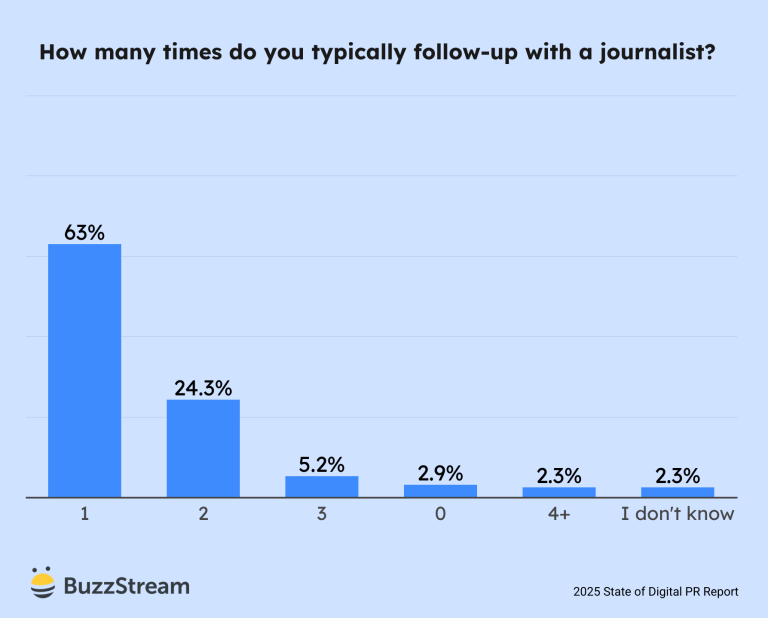
Muck Rack’s State of Journalism found that 51% say one follow-up is ideal (and 48% say it should come within 3–7 days).
With all of this information coming at us, it’s hard to understand the best practice.
So, I analyzed over 65K campaigns and over 8 million emails using BuzzStream’s data to understand the impact of follow-up emails in digital PR campaigns.
How Do Follow-Ups Impact Open Rates?
Let’s start at the top.
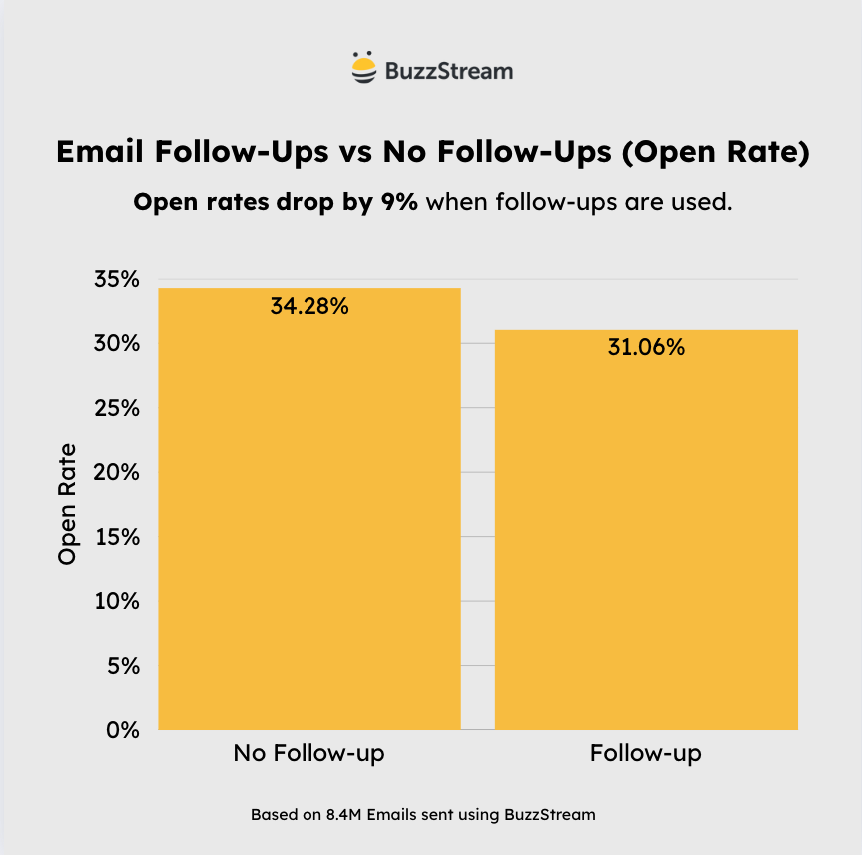
Campaigns using follow-ups have slightly lower open rates (31.06%) than those without (34.28%).
Although open rates are flawed metrics due to their propensity to be skewed by Apple and Google auto-opens, they are still directionally helpful at scale.
Since we’ve examined over 8 million emails sent, I feel confident that this data tells us something significant.
This drop in opens for follow-up emails may make you rethink scheduling follow-ups, but open rates tell a different story than replies.
How Do Follow-Ups Impact Reply Rates?
Sequences with follow-ups see an 85% higher reply rate than one-and-done emails.
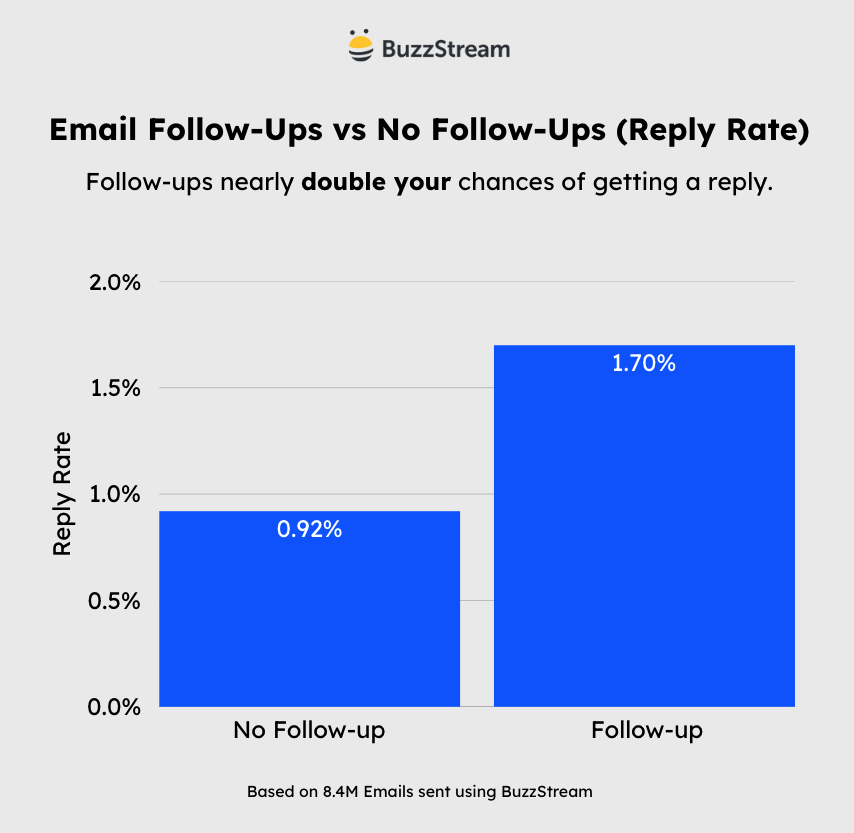
Put plainly, follow-ups nearly double your chances of getting a reply.
Why is there a low open rate but a higher reply rate?
Think about how often you’ve gotten an email you aren’t interested in, so you’ve ignored it the second time.
From the journalists I’ve talked to, this is what is happening; when the story interests them, the follow-up is an effective nudge.
Before we get into the number of follow-ups, I wanted to see if this held at the industry level.
Do Reply Rates For Follow-Ups Vary By Industry?
Here’s a breakdown of reply rates for campaigns with follow-up emails vs those without at the industry level.
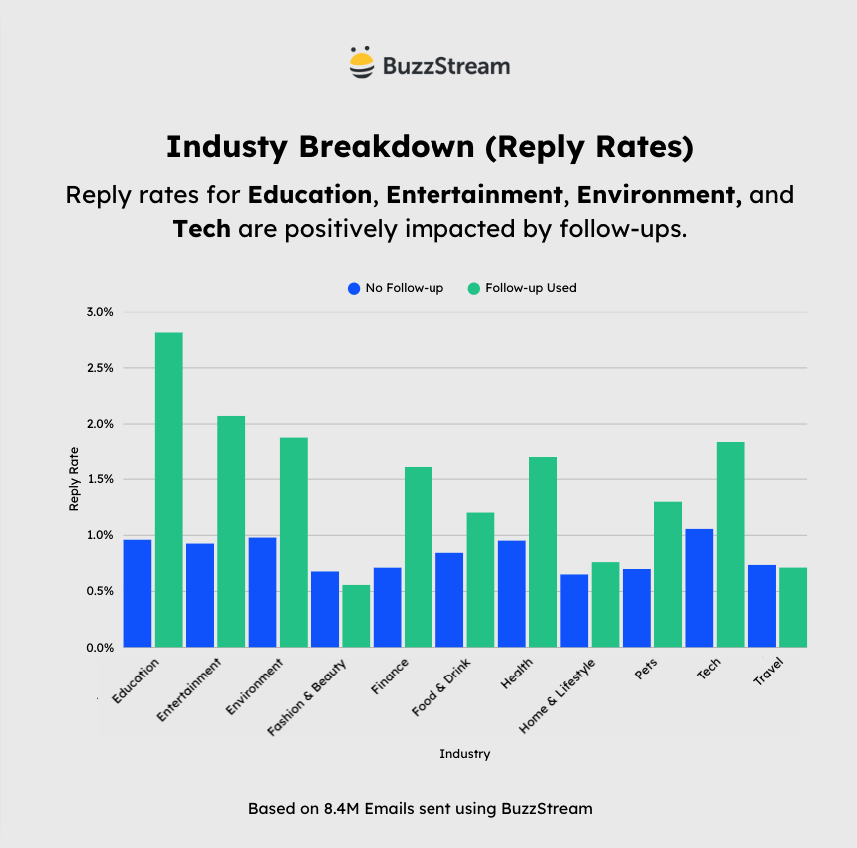
In almost all cases, reply rates are better when a follow-up is used.
Most industries see a meaningful lift from follow-ups, often doubling reply rates.
Education, Entertainment, and Tech see the most significant boost in reply rate when follow-ups are used.
This may be because the Entertainment and Tech industries often move quickly, but that may be a broad generalization.
Travel and Fashion had the same or slightly worse reply rates when follow-ups were used. My thought here is that both are fairly time-sensitive with potentially tighter editorial calendars.
So, if a pitch didn’t land the first time, the moment may have already passed.
The critical takeaway is that reply rates are consistently better for follow-up campaigns.
Now that we know this, let’s look at the number of follow-ups that make an impact.
Does the Number of Follow-Ups Impact Open Rates?
Cision’s State of the Media Report in 2024 found that only 8% of journalists think it’s OK to follow up more than once.
Let’s see how the data plays out to support this.
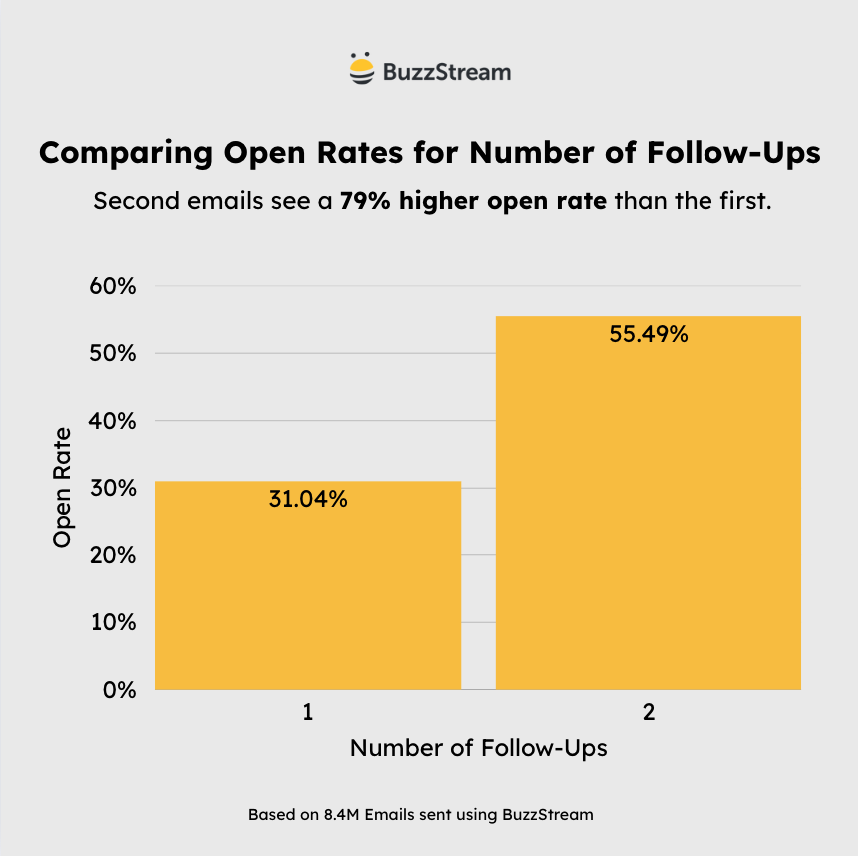
For those using follow-ups, the second emails see a 79% higher open rate than the first.
This increase could be because the sender’s name is more recognizable.
Another theory from digital PRs I talked to is that we often change the subject line after the first follow-up, so perhaps the fresh subject line is getting a better response.
But there’s a twist when you look at replies…
Does the Number of Follow-Ups Impact Reply Rates?
The trend flips when looking at reply rates, and we see lower reply rates (0.59%) for the second email compared to the first follow-up (1.74%).
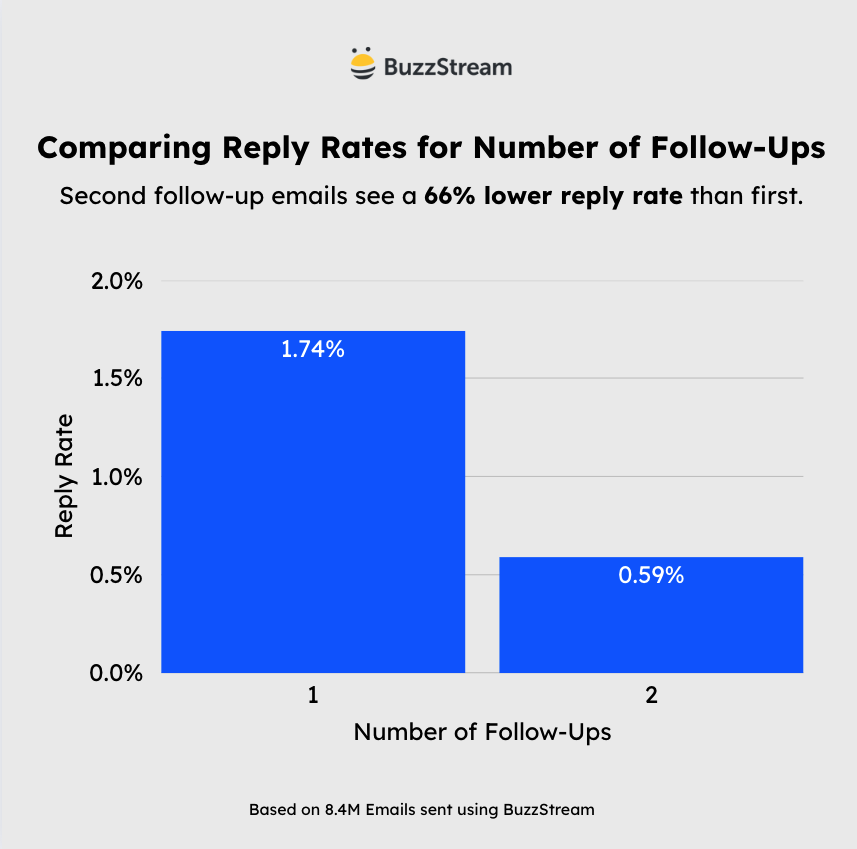
This drop equals a 66% decrease in reply rate from the first email to the follow-up.
The reason here is most likely the same trend we saw when comparing replies to opens for campaigns using follow-ups vs not.
Suppose a journalist isn’t interested the first time. In that case, they will rarely be interested the second time around (or you might just be catching the majority of receptive journalists on the first follow-up).
Half of the journalists Cision surveyed said that following up repeatedly is a great way to make them block you!
Now that we know which follow-up seems to impact reply rates the most, let’s examine the time between follow-ups.
How Many Days Should You Wait To Send Your Follow-Ups?
Open rates peak on Day 1 (~38%) and taper off the rest of the day.
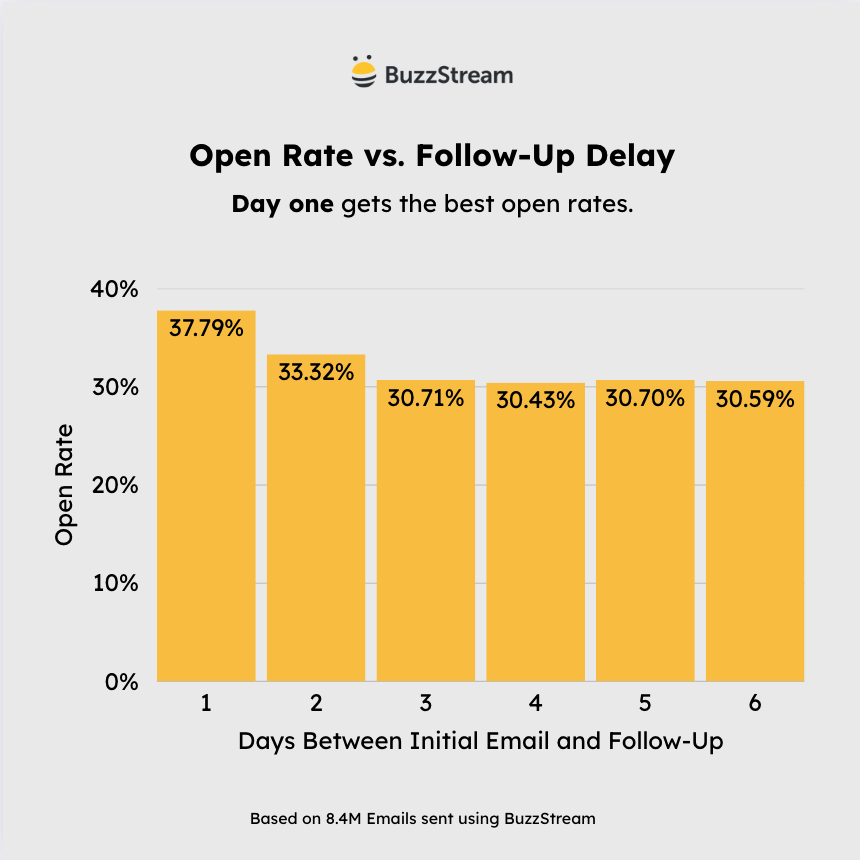
Interestingly, fewer people are interested after day one, regardless of the subject line.
But let’s see if that holds with the reply rate next.
As you can see, the follow-up emails sent after one day get the best reply rates.
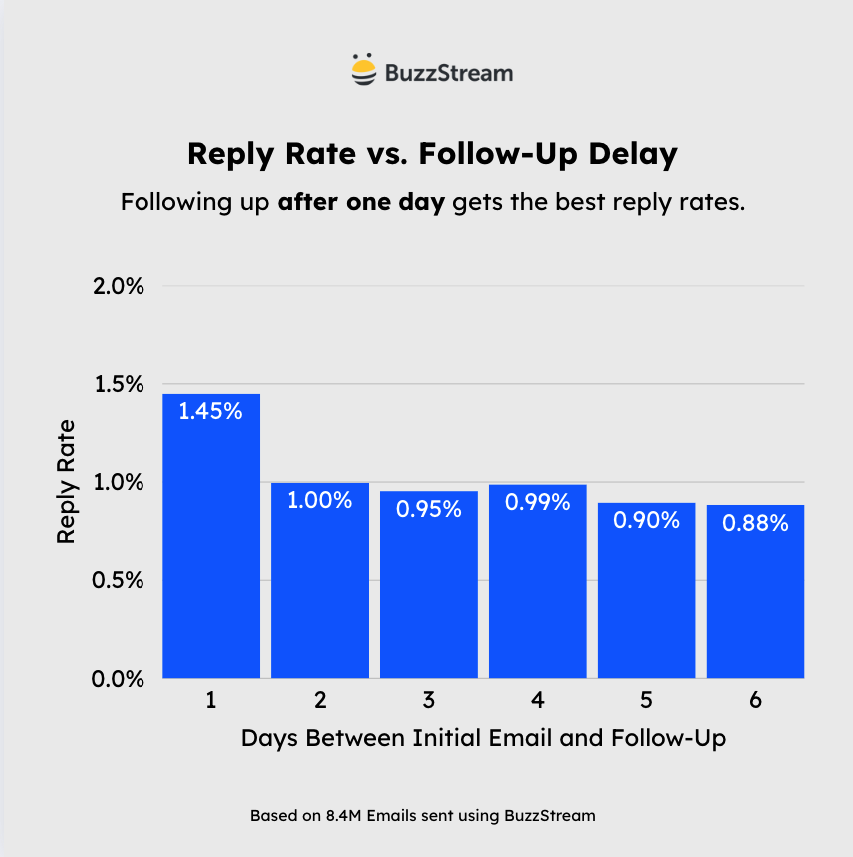
So, if you’re going to follow up, do it fast, within a day.
3 Tips From Experts For Sending Follow-Ups
This post hasn’t uncovered (but I will in a subsequent report) the kind of subject lines or approaches these successful digital PRs have used to get these results.
You can find some great follow-up emails in our templates post, but I will share a few tips we’ve learned from our experts on the podcast.
1. Refresh the Angle in Each Follow-Up
Alice Walker-Gibbons, digital PR lead at Embryo, told me they play around with different angles for each email in the sequence.
So, for a pitch about a norovirus data study they did, “the first angle will be the norovirus original data, but then in the follow-up, we might use a secondary angle in the pitch.
So, if anything new comes out about norovirus, we can add to and refresh it.
Or, maybe we just try a more general kind of winter health angle.
So the follow-up is where you can play around with the pitch.”
(Check out the full episode with Alice.)
I love this idea of adding new value.
As Britt Klontz of Vada Communications put it in our podcast:
“I tend to try to follow up only once unless I notice someone’s opening my email quite a few times.
But when I do follow up, I tend to have something of value to offer up.”
That’s a solid rule to follow.
2. Hold off on the Expert Commentary
Bekki Ramsey, founder of BELTA PR, shared an interesting tactic for adding more value, but specifically to expert commentary.
Pretty much every digital PR will tell you that expert commentary or a quote is a must in any media pitch.
But Bekki sometimes holds back on expert commentary until the follow-up.
“I know a lot of PRs will be against that, but in my eyes, I know that if a journalist wants to cover it…they’re going to email me back and say, ‘have you got an expert comment on this,’ and I’ll send one then.
So, it enables me to send that chaser email and say, ‘I know that you’ve opened this email a couple of times,’ I’ll suggest an exclusive comment specifically for them.”
This makes total sense because it follows that personalized outreach approach.
(Check out the full podcast episode with Bekki.)
3. The Case For More Follow-Ups
The last tip goes against the research we’ve found in this post, but it is still crucial because journalists are very busy these days.
Jaclyn Lambert of Jaclynlambert.com told us that she’s recently felt like she has to follow up more times than ever before to get through.
“What I’m noticing with my own work—and I think this is a byproduct of people being laid off—is that newsrooms are running leaner than ever before.
So, there are fewer people to pitch.
I collaborated recently with Fox Business, and it took more follow-ups than I was comfortable sending, but I really needed to get a win.
It ended up getting passed on to someone else within the team because my contact was too busy.”
Does this mean you should spam everyone?
Definitely not.
But if you really think your post is a great fit for the journalist, it can’t hurt to send two or three follow-ups.
Just Following Up
Even though we’ve provided some data on the number of follow-ups you should send, it’s never a one-size-fits-all approach.
You should treat any of your outreach as a mass-produced strategy.
We’ve found time and again that the smaller, personalized approach will always get the best result.
And that carries over to your email follow-ups.

 End-to-end outreach workflow
End-to-end outreach workflow



 Check out the BuzzStream Podcast
Check out the BuzzStream Podcast







